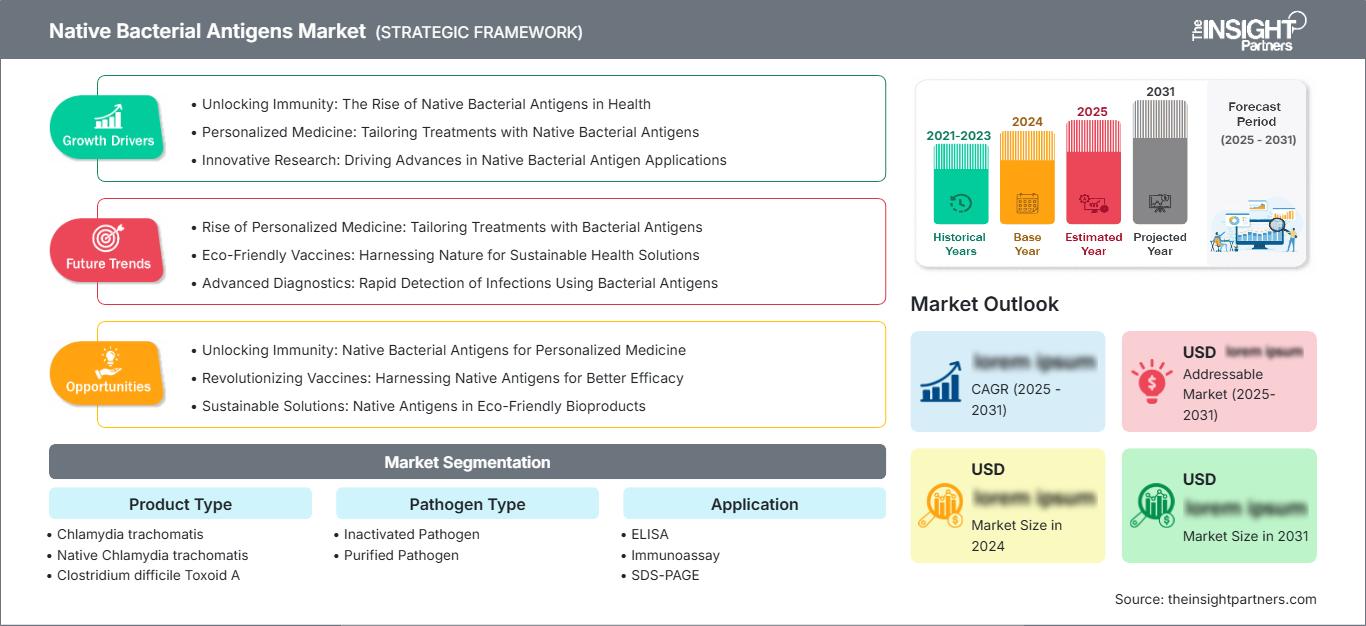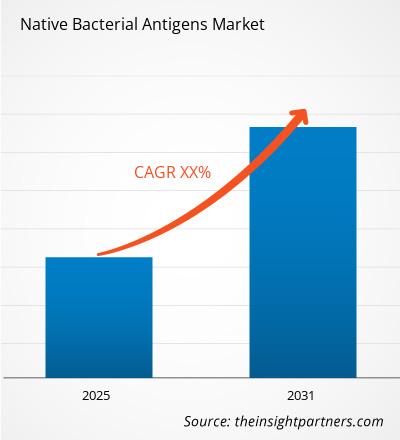Si prevede che il mercato degli antigeni batterici nativi registrerà un CAGR del XX% dal 2025 al 2031, con una dimensione del mercato in espansione da XX milioni di dollari USA nel 2024 a XX milioni di dollari USA entro il 2031.
Il rapporto è suddiviso in base al tipo di prodotto (Chlamydia trachomatis, Chlamydia trachomatis nativa, Clostridium difficile Tossoide A, Clostridium difficile Tossoide B, Acido lipoteicoico nativo) e analizza ulteriormente il mercato in base al tipo di patogeno (patogeno inattivato, patogeno purificato). Esamina inoltre il mercato per applicazione (ELISA, immunodosaggio, SDS-PAGE, emoagglutinazione, test di agglutinazione) e per utente finale del settore (laboratori e centri diagnostici, istituti accademici e di ricerca). Per ciascuno di questi segmenti chiave viene fornita una ripartizione completa a livello globale, regionale e nazionale. Il rapporto include le dimensioni del mercato e le previsioni per tutti i segmenti, presentando i valori in USD. Fornisce inoltre statistiche chiave sullo stato attuale del mercato dei principali attori, insieme ad approfondimenti sulle tendenze di mercato prevalenti e sulle opportunità emergenti.
Scopo del rapporto
Il rapporto Native Bacterial Antigens Market di The Insight Partners mira a descrivere il panorama attuale e la crescita futura, i principali fattori trainanti, le sfide e le opportunità. Ciò fornirà spunti a vari stakeholder aziendali, come:
- Fornitori/produttori di tecnologia: per comprendere le dinamiche di mercato in evoluzione e conoscere le potenziali opportunità di crescita, consentendo loro di prendere decisioni strategiche informate.
- Investitori: per condurre un'analisi completa delle tendenze in merito al tasso di crescita del mercato, alle proiezioni finanziarie del mercato e alle opportunità esistenti lungo la catena del valore.
- Organismi di regolamentazione: per regolamentare le politiche e le attività di controllo nel mercato con l'obiettivo di ridurre al minimo gli abusi, preservare la fiducia degli investitori e sostenere l'integrità e la stabilità del mercato.
Segmentazione del mercato degli antigeni batterici nativi Tipo di prodotto
- Chlamydia trachomatis
- Chlamydia trachomatis nativa
- Tossoide A di Clostridium difficile
- Tossoide B di Clostridium difficile
- Acido lipoteicoico nativo
Tipo di patogeno
- Patogeno inattivato
- Patogeno purificato
Applicazione
- ELISA
- Immunoassay
- SDS-PAGE
- Emoagglutinazione
- Test di agglutinazione
Utente finale
- Laboratori e centri diagnostici
- Istituti accademici e di ricerca
Potrai personalizzare gratuitamente qualsiasi rapporto, comprese parti di questo rapporto, o analisi a livello di paese, pacchetto dati Excel, oltre a usufruire di grandi offerte e sconti per start-up e università
Mercato degli antigeni batterici nativi: Approfondimenti strategici

-
Ottieni le principali tendenze chiave del mercato di questo rapporto.Questo campione GRATUITO includerà l'analisi dei dati, che vanno dalle tendenze di mercato alle stime e alle previsioni.
Fattori di crescita del mercato degli antigeni batterici nativi
- Sbloccare l'immunità: l'ascesa degli antigeni batterici nativi in ambito sanitario
- Medicina personalizzata: personalizzare i trattamenti con antigeni batterici nativi
- Ricerca innovativa: promuovere i progressi nelle applicazioni degli antigeni batterici nativi
Tendenze future del mercato degli antigeni batterici nativi
- Ascesa della medicina personalizzata: personalizzare i trattamenti con antigeni batterici
- Vaccini ecocompatibili: sfruttare la natura per soluzioni sanitarie sostenibili
- Diagnostica avanzata: rilevamento rapido delle infezioni mediante antigeni batterici
Opportunità di mercato degli antigeni batterici nativi
- Sbloccare l'immunità: i farmaci nativi Antigeni batterici per la medicina personalizzata
- Rivoluzionare i vaccini: sfruttare gli antigeni nativi per una migliore efficacia
- Soluzioni sostenibili: antigeni nativi in bioprodotti ecocompatibili
Mercato degli antigeni batterici nativi
Le tendenze regionali e i fattori che influenzano il mercato degli antigeni batterici nativi durante il periodo di previsione sono stati ampiamente spiegati dagli analisti di The Insight Partners. Questa sezione illustra anche i segmenti e la geografia del mercato degli antigeni batterici nativi in Nord America, Europa, Asia-Pacifico, Medio Oriente e Africa, America meridionale e centrale.
Ambito del rapporto di mercato sugli antigeni batterici nativi
| Attributo del rapporto | Dettagli |
|---|---|
| Dimensioni del mercato in 2024 | US$ XX Million |
| Dimensioni del mercato per 2031 | US$ XX Million |
| CAGR globale (2025 - 2031) | XX% |
| Dati storici | 2021-2023 |
| Periodo di previsione | 2025-2031 |
| Segmenti coperti |
By Tipo di prodotto
|
| Regioni e paesi coperti |
Nord America
|
| Leader di mercato e profili aziendali chiave |
|
Densità degli attori del mercato degli antigeni batterici nativi: comprendere il suo impatto sulle dinamiche aziendali
Il mercato degli antigeni batterici nativi è in rapida crescita, trainato dalla crescente domanda degli utenti finali dovuta a fattori quali l'evoluzione delle preferenze dei consumatori, i progressi tecnologici e una maggiore consapevolezza dei benefici del prodotto. Con l'aumento della domanda, le aziende stanno ampliando la propria offerta, innovando per soddisfare le esigenze dei consumatori e sfruttando le tendenze emergenti, alimentando ulteriormente la crescita del mercato.

- Ottieni il Mercato degli antigeni batterici nativi Panoramica dei principali attori chiave
Punti di forza
- Copertura completa: il rapporto copre in modo completo l'analisi di prodotti, servizi, tipologie e utenti finali del mercato degli antigeni batterici nativi, fornendo un panorama olistico.
- Analisi degli esperti: il rapporto è compilato sulla base della conoscenza approfondita di esperti e analisti del settore.
- Informazioni aggiornate: il rapporto garantisce rilevanza aziendale grazie alla sua copertura di informazioni recenti e tendenze dei dati.
- Opzioni di personalizzazione: questo rapporto può essere personalizzato per soddisfare le esigenze specifiche del cliente e adattarsi in modo appropriato alle strategie aziendali.
Il rapporto di ricerca sul mercato degli antigeni batterici nativi può, quindi, aiutare a guidare il percorso di decodificazione e comprensione dello scenario del settore e delle prospettive di crescita. Sebbene possano esserci alcune preoccupazioni valide, i vantaggi complessivi di questo rapporto tendono a superare gli svantaggi.
- Analisi storica (2 anni), anno base, previsione (7 anni) con CAGR
- Analisi PEST e SWOT
- Valore/volume delle dimensioni del mercato - Globale, Regionale, Nazionale
- Industria e panorama competitivo
- Set di dati Excel
Report recenti
Testimonianze
Motivo dell'acquisto
- Processo decisionale informato
- Comprensione delle dinamiche di mercato
- Analisi competitiva
- Analisi dei clienti
- Previsioni di mercato
- Mitigazione del rischio
- Pianificazione strategica
- Giustificazione degli investimenti
- Identificazione dei mercati emergenti
- Miglioramento delle strategie di marketing
- Aumento dell'efficienza operativa
- Allineamento alle tendenze normative






















 Ottieni un campione gratuito per - Mercato degli antigeni batterici nativi
Ottieni un campione gratuito per - Mercato degli antigeni batterici nativi